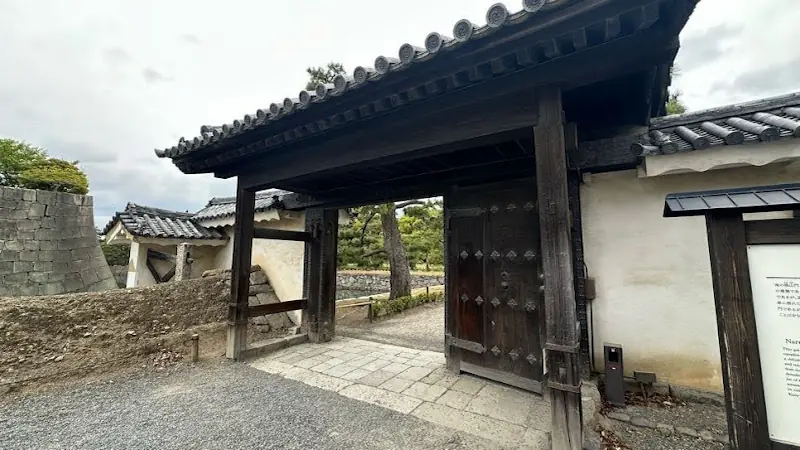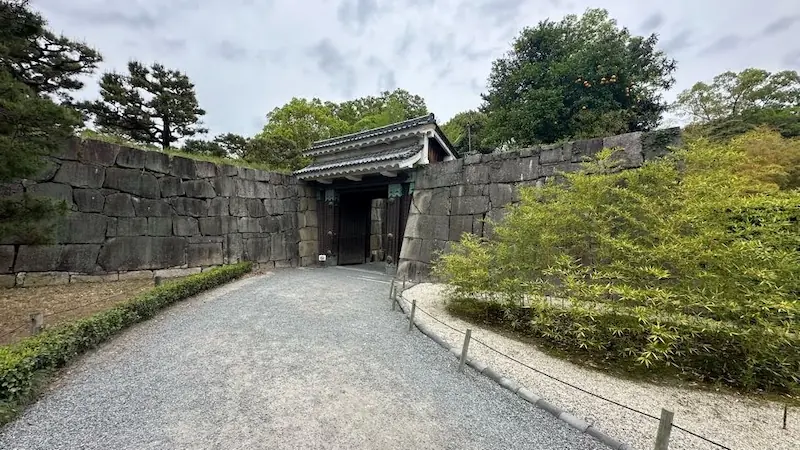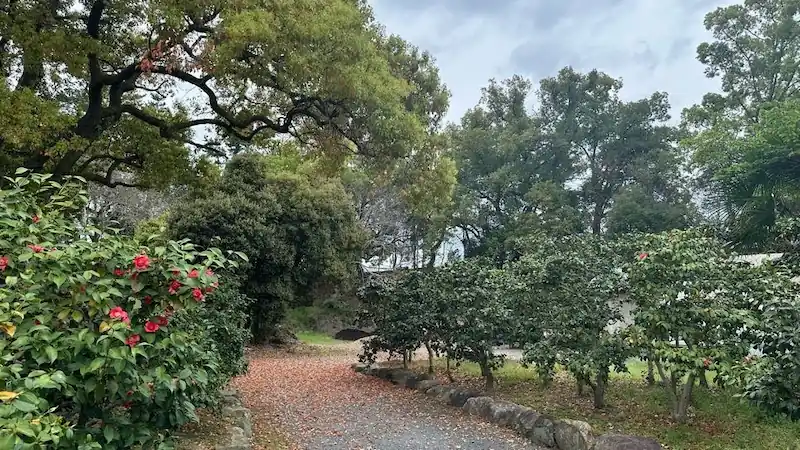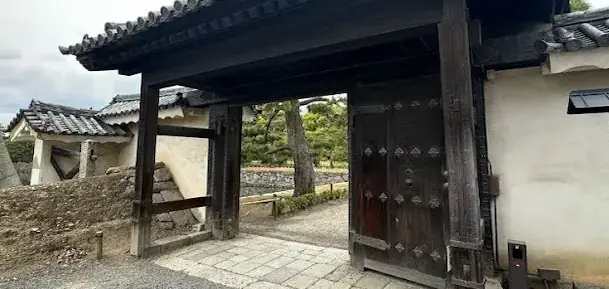The Castle’s Overlooked “Supporting Cast”
The gates and defensive works that supported Nijo Castle embody Edo-period fortification thinking.
Guarding the approaches north and south, the Naruko Gate and the North Middle Partition Gate are compact but ingeniously designed. And the site of the Northwest Corner Turret—lost in the Great Tenmei Fire—still quietly bears witness to a vanished stronghold. In these details lies the castle’s true value.
Naruko Gate

🏛 Overview
The Naruko Gate stands on the north side of Nijo Castle’s Honmaru and dates to around 1626 (Kanei 3). It forms a defensive pair with the Momoyama Gate to the south, strengthening the Honmaru’s perimeter.
Structurally it is a shikyakumon (“four-post” gate) with buttress posts on both the front and rear. Because the front posts project only slightly, it doesn’t immediately look like a four-post gate. This subtle projection is thought to mitigate a weakness of the type: if the buttress posts were destroyed, the gate could collapse. Gates of this configuration are extremely rare within Nijo Castle—the only other example with similar structure is the Karamon.
| Item | Details |
|---|---|
| Year Built | 1625–1626 (Keicho 7–8) and around 1626 (Kanei 3) |
| Builder | Unknown (likely part of shogunate-led castle works) |
| Structure & Features | Single-bay gate with side wicket doors; single story; gabled, tiled roof. Formally a “four-post gate” with front and rear buttress posts, but the short projection makes this hard to spot at a glance. Paired with the Momoyama Gate to defend the Honmaru from the north. |
| Repairs & Restoration | Few explicit records; periodic maintenance and repairs are presumed. |
| Current Status | Extant; designated an Important Cultural Property of Japan. |
| Loss/Damage | No confirmed record of major burning or destruction. |
| Cultural Property Status | Important Cultural Property (designated October 28, 1939) |
| Notes | Compact in appearance yet noteworthy for its rare structural type. Marks the northern end of the passageway dividing the Ninomaru and the Honmaru; positioned opposite the Momoyama Gate. Roof tiles include decorative elements modeled on chrysanthemum motifs. |
🗺 Address:
541 Nijojo-cho, Nakagyo Ward, Kyoto, Kyoto Prefecture
🚶 Access
About a 2-minute walk (approx. 120 m) from the eastern limit of the ancient Heian Palace site.
⏳ Suggested Time
Quick highlights: ~10 minutes
Leisurely visit: ~20 minutes (to study the gate and adjacent defenses in detail)
📍 Highlights
🔹 Four-Post Gate Structure:
The Naruko Gate is a shikyakumon with front and rear buttress posts. The shallow projection is thought to reduce the risk that destroying the posts would topple the gate.
🔹 Counterpart to the Momoyama Gate:
Paired with the Momoyama Gate to the south, it strengthens the Honmaru’s defenses. Comparing the two helps you read Edo-period security strategy in plan.
🔹 Rare Configuration:
Within Nijo Castle, only the Karamon shares a comparable structural concept—making this gate a rarity.
📌 Trivia
💡 Historical Context:
Built around 1626 (Kanei 3), the gate reflects contemporary defensive thinking and carpentry techniques.
💡 Look for the Crest:
Check the onigawara ridge-end tiles for the Tokugawa triple-hollyhock crest—finely detailed craftsmanship.
💡 Imperial Connection:
Sources suggest the Naruko Gate was refined for Emperor Go-Mizunoo’s procession, potentially serving as part of a secure route through the grounds.
North Middle Partition Gate

🏛 Overview
Positioned on the north side of the Honmaru, the North Middle Partition Gate dates to around 1626 (Kanei 3). It pairs with the South Middle Partition Gate to fortify the Honmaru’s inner circuit.
The gate is a compact, single-bay structure with a pent-roof canopy and tiled hip-and-gable roof. Enclosed by stone walls, it is an example of an uzumi-mon (“buried gate”) where masonry flanks the passage and part of the roof is recessed into the stonework, enhancing protection against intruders.
The approach is not straight; it jogs in a crank-like turn to complicate enemy movement and increase defensive advantage. Such passages were commonly adopted at key strongpoints in Edo-period castle design.
| Item | Details |
|---|---|
| Year Built | Circa 1625–1626 (Kanei 2–3) |
| Builder | Tokugawa Iemitsu (as part of Edo shogunate improvements to the Honmaru) |
| Structure & Features | Small single-bay gate; hip-and-gabled, tiled roof. Paired with the South Middle Partition Gate; partitions the boundary between the Ninomaru and West Ninomaru. Unadorned but practical, with stout door hardware and buttress posts. |
| Repairs & Restoration | Roof re-tiling and door maintenance carried out since the Edo period. |
| Current Status | Extant; preserved and open to visitors alongside the South Middle Partition Gate. |
| Loss/Damage | No records of loss due to fire or war damage. |
| Cultural Property Status | Important Cultural Property of Japan (designated October 28, 1939) |
| Notes | Its pairing with the South Middle Partition Gate exemplifies Nijo Castle’s layered defenses. Thick ironmongery points to a thoroughly practical, battle-ready design. Its position along the north-side passage of the Ninomaru can still be identified today. |
🗺 Address:
541 Nijojo-cho, Nakagyo Ward, Kyoto, Kyoto Prefecture
🚶 Access
About a 2-minute walk (approx. 150 m) from the Naruko Gate.
⏳ Suggested Time
Quick highlights: ~10 minutes
Leisurely visit: ~20 minutes (to study the gate and adjacent defenses in detail)
📍 Highlights
🔹 Uzumi-mon Construction:
Flanking stone walls embrace the passage, with part of the roof recessed into the masonry—an arrangement that increases protection against assault.
🔹 Cranked Passage:
The route bends rather than running straight, complicating an attacker’s advance and improving defensive control—textbook Edo-period fortification planning.
🔹 Counterpart to the South Gate:
As the northern partner to the South Middle Partition Gate, it completes a deliberate choke-point system around the Honmaru.
📌 Trivia
💡 Historical Context:
Built around 1626 (Kanei 3), the gate showcases the era’s defensive logic and building techniques.
💡 Crest Spotting:
Look for onigawara ridge tiles bearing the Tokugawa triple-hollyhock—a hallmark detail.
💡 Imperial Route:
Some accounts indicate the gate’s route was refined for Emperor Go-Mizunoo’s progress, doubling as a secure corridor.
Site of the Northwest Corner Turret

🏛 Overview
These ruins mark the former corner turret at the northwest angle of Nijo Castle’s outer moat. Historically, Nijo Castle had nine turrets in total—at the four corners of both the outer and inner moats, plus one at the center of the outer moat’s north side. Two turrets on the north were lost in the Great Tenmei Fire of 1788, and today only the Southeast and Southwest Corner Turrets survive. The Northwest Corner Turret was destroyed in that fire and was never rebuilt.
Turrets served as watchtowers and armories—key nodes in the castle’s defensive network. Situated where the outer and inner moats converged, the Northwest Corner Turret likely safeguarded the approaches from the northwest and coordinated with neighboring turrets to form a continuous defensive line.
Today, foundation stones and portions of the rampart remain, evoking the scale and form of the lost structure. On-site signage provides historical context for visitors.
| Item | Details |
|---|---|
| Year Built | Circa 1626 (Kanei 3), during Tokugawa Iemitsu’s Honmaru works |
| Builder | Tokugawa Iemitsu (Edo Shogunate) |
| Structure & Features | Corner turret at the northwest of the Honmaru. Two stories over two tiers; hip-and-gabled, tiled roof; a key defensive node. Sited to monitor both the north and west, linking with other corner turrets to complete the defensive circuit. |
| Repairs & Restoration | Repaired during the Edo period; never reconstructed after its loss. Only the stone base of the turret platform survives. |
| Current Status | The superstructure no longer exists. Believed destroyed in the 1788 (Tenmei 8) conflagration; only the site remains. |
| Loss/Damage | Burned down in the Great Tenmei Fire of 1788; not rebuilt thereafter. |
| Cultural Property Status | No separate designation for the site; preserved as part of the castle remains. |
| Notes | Nijo Castle originally had turrets at all four corners; only the southeast and southwest examples survive today. The northwest site lies in the Honmaru’s northwest area; fragments of the stonework are visible. From here you can look over the north moat and out toward central Kyoto. |
🗺 Address:
541 Nijojo-cho, Nakagyo Ward, Kyoto, Kyoto Prefecture
🚶 Access
Starting point: about a 5-minute walk (approx. 300 m) from the North Middle Partition Gate.
⏳ Suggested Time
Quick highlights: ~10 minutes
Leisurely visit: ~20 minutes (to examine the stonework and surrounding defenses)
📍 Highlights
🔹 Stonework Anatomy:
Foundation blocks and sections of the rampart reveal construction techniques of the Edo period—look closely at the dressing and coursing of stones.
🔹 Defensive Context:
Traces of the outer moat and earthen walls nearby help you visualize how the turret anchored the northwest sector of the castle’s defenses.
🔹 On-Site Signage:
Information boards explain the history and function of the turret and the impact of the 1788 conflagration.
📌 Trivia
💡 Lost to the Flames:
The Northwest Corner Turret was destroyed in the Great Tenmei Fire of 1788, which also consumed another turret on the castle’s north side.
💡 Masonry as a Textbook:
The surviving stonework preserves the DNA of Edo-period castle engineering—an open-air lesson in techniques and tooling marks.
💡 Symbols of Power:
As part of the fortress built under Tokugawa Ieyasu’s authority, the turrets symbolized shogunal power. The 1788 fire devastated much of Kyoto, and this turret was among its casualties.




comment